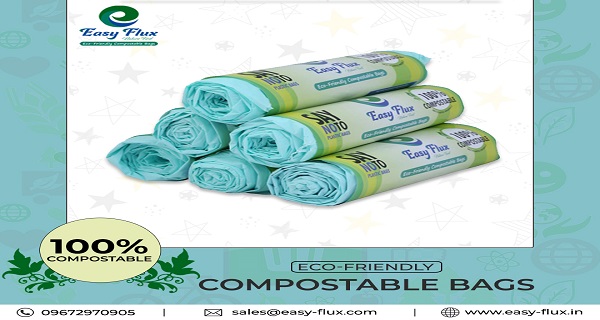Compostable Bags and its benefits | Easy Flux Bags
How the Compostable Bags Come Too Great Use
Disposable plates, glasses, boxes, cutlery, just strolling around a mall's food court to find a large amount of such practical and everyday material. What a lot of people don't know, however, is that part of those items is already being made from natural materials like cassava and sugarcane. As this type of production leads to biodegradable objects, its disposal culminates in the degradation of waste by bacteria and further transformation into organic compost. The promising idea to reduce the amount of waste in landfills already has a name: it is called compostable packaging. Industry giants, are already betting on the green side, meeting the proposal of sustainability linked to the corporate environment and the trend of green consumers. The first company has invested in the creation of a paper cup, while the second already has a packaging made of the material to store their laptops.
Compostable packaging: green manufacturing process
At this point, it is important to note that the process of manufacturing a compostable packaging itself is cleaner than that of petroleum-based plastics: in the case of sustainable packaging production, there is less greenhouse gas generation since that bioplastic does not contain a hazardous chemical. Composed of non-polluting substances, bio plastics comprise three types of materials: polymers made wholly or partially from renewable sources, biodegradable from fossil sources or polymers from renewable and biodegradable sources. Most bio plastics / bio polymers produced in the world today originate from renewable and certified compostable raw materials. Such materials do not need fossil carbon for their production,
The need for proper disposal
Although they already represent an environmentally friendly product manufactured by a process aimed at sustainability, compostable packaging demands proper and conscious disposal. Otherwise, these products have the risk of being deposited in dumps where there is no sorting of materials. Proper disposal of items can be done by degradability, oxidation (through metal salts), water degradation (through hydrolysis), photo degradation (using light) or even biodegradable through the natural action of microorganisms.
In addition, landfilling is not recognized as a form of organic recycling. The irresponsible disposal of a compostable packaging can compromise its recycling or biodegrading quality, making it as harmful as non-biodegradable packaging. For this reason, the adoption of type II environmental labeling, (self-declarations) as required by ISO certified biodegradable bags manufactures company which is mandatory, so that the best way to handle the packaging after use is always clearly indicated.
Positive environmental impact: the issue of waste reuse and other advantages
The use of compostable packaging is a complementary alternative to recycling and allows, in addition to ecological gains, the continuity of productive activities of workers living this function, which does not cause disturbance to the surrounding communities. The use of such products, however, is still in its infancy, although there is currently a strong demand for short-life packaging (such as those mentioned at the beginning of the article and commonly found in shopping mall food courts and large events).
In addition to promoting the reuse of organic waste and helping to reduce the volume of waste in landfills, compostable packaging still has excellent quality and resistance to water absorption, and act against global warming and the greenhouse effect. Compared to other similar materials, in fact, their manufacturing process promotes a reduction in carbon dioxide levels in the atmosphere.
Advantages of Biodegradable Materials
Globally certified as compostable materials, they are innovative and sustainable solutions that have great advantages over normal plastics. Among them, it is possible to mention the reduction of impacts on the environment, since, at the end of its useful life, the plastic becomes water, CO2 and fertilizer. This significantly reduces disposal in landfills and dumps, generating a compost that can be used on small farms and city parks, for example.
Currently, the main applications for these bio plastics are:
Assistance in the management of organic solid waste: In the form of organic waste bags, bio plastics is an excellent alternative for the collection and disposal of organic waste to composting plants. Today, conventional plastic bags are used in the logistics of organic waste, which entails high labor and energy costs to separate these packages in the composting plants, where the fertilizer is produced. The bag produced expert solution does not have to be separated at the composting plant.
Plastics for agriculture in order to conserve the ambient temperature and protect weed crops: The major advantage over conventional plastics is that at each planting cycle producers have to remove conventional plastics from the field. Film removal is not complete and leaves plastic residue in the environment, depleting the soil.
Packaging in general: Experts have biodegradable and compostable packaging solution, produced in, various types of processing process. The main packaging market happens to be intended for the production of bags in general at points of sale such as supermarket, department stores, and others.



Comments
Post a Comment